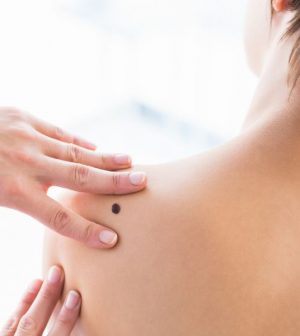- Navigating Your Midlife Crisis: Embracing New Possibilities
- City Raccoons Showing Signs of Domestication
- Mapping the Exposome: Science Broadens Focus to Environmental Disease Triggers
- One Week Less on Social Media Linked to Better Mental Health
- Your Brain Changes in Stages as You Age, Study Finds
- Some Suicide Victims Show No Typical Warning Signs, Study Finds
- ByHeart Formula Faces Lawsuits After Babies Sickened With Botulism
- Switch to Vegan Diet Could Cut Your Greenhouse Gas Emissions in Half
- Regular Bedtime Does Wonders for Blood Pressure
- Dining Alone Could Mean Worse Nutrition for Seniors
Does Healthy Skin Around Suspicious Moles Need Removal?

If you’re having a suspicious mole removed, the doctor should consider removing about 2 millimeters of healthy skin from around the mole. Doing so could avoid the need for a second surgery if the mole turns out to be cancerous, according to a new report.
In the study, researchers removed about 150 suspicious moles from nearly 140 men and women. All of them had at least 2 millimeters (mm) of skin removed around the outside edges of the moles. Doctors call that healthy skin from around the mole “the margin.”
“Although the vast majority of suspicious-looking skin moles do not turn out to be cancerous melanomas, once a decision has been made to remove a mole, there should be a clearer standard margin,” said senior study investigator Dr. David Polsky. He is a dermatologist and professor of dermatologic oncology at NYU Langone Health in New York City.
Polsky noted that most surgeons remove either just the darkest portion of a suspicious mole or, when removing the entire mole, cut out an imprecise 1-mm margin around the mole’s edge.
In the new study, 90 percent of the moles were completely removed with a single procedure. Seven percent of the moles were diagnosed as melanoma, the most aggressive form of skin cancer.
Over a follow-up of about 18 months, none of the patients had any further suspicious growths at the surgery sites, the study found.
“Our study shows that a ‘one and done’ approach with a clearly defined, slightly larger margin is safer and more effective in completely removing suspicious moles with a single procedure than the current non-standardized approach,” Polsky said in an NYU Langone news release.
As many as two-thirds of the hundreds of thousands of suspicious moles removed each year in the United States require further surgery because cancerous mole cells were missed during the first surgery, according to the researchers.
These second procedures increase the risk of infection, bleeding and scarring, and also lead to higher costs, the study authors pointed out.
Findings from the study were published Oct. 2 in the Journal of the Academy of Dermatology.
More information
The U.S. National Cancer Institute explains skin cancer screening.
Source: HealthDay
Copyright © 2025 HealthDay. All rights reserved.










